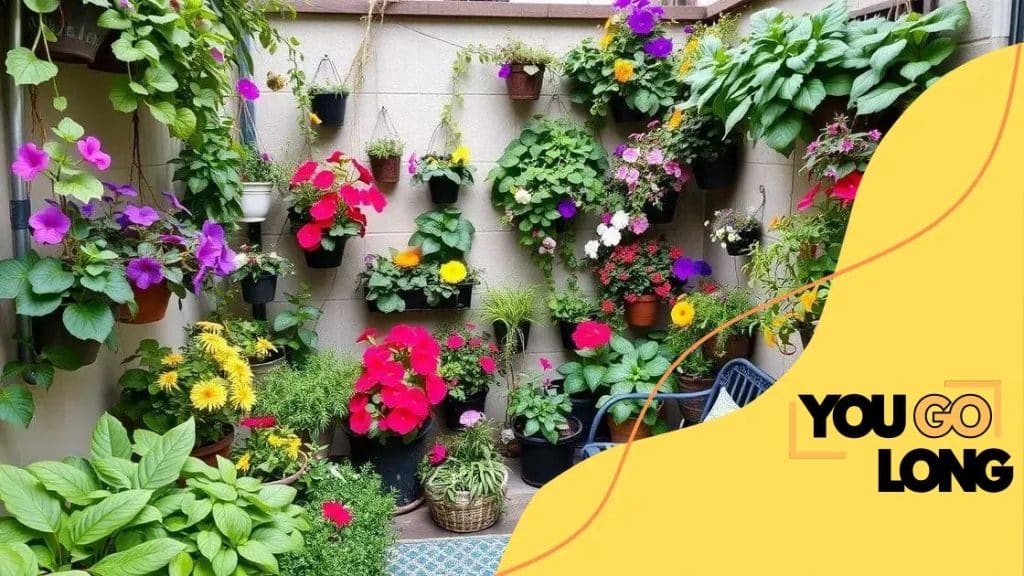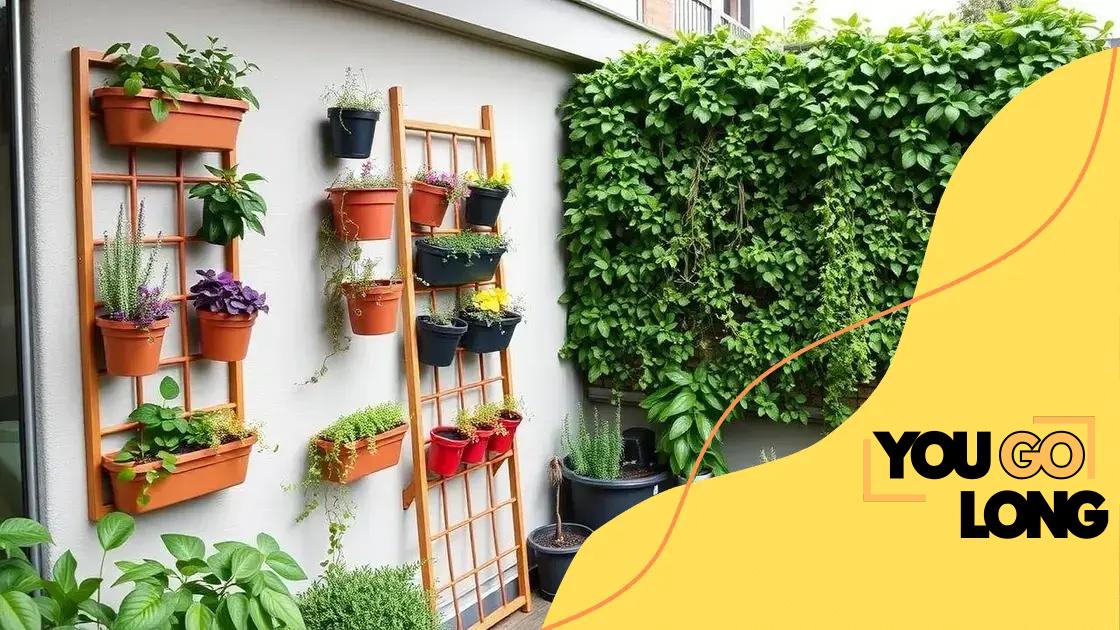Gardening tips for small apartment balconies

Advertisement
Gardening tips for small apartment balconies include choosing compact plants, maximizing sunlight exposure, establishing a consistent watering schedule, utilizing vertical gardening solutions, and investing in essential tools to create a vibrant green space.
Gardening tips for small apartment balconies can turn even the tiniest space into a green haven. Have you ever imagined sipping your coffee amidst vibrant blooms? Let’s explore how you can cultivate your little oasis.
Choosing the right plants for small spaces
Choosing the right plants for small spaces can make a big difference in your balcony garden. With limited room, it’s essential to select plants that thrive in tight conditions.
Consider Plant Size
Start by thinking about how big your plants will grow. Small or compact varieties are often the best choices for balcony gardening. Consider herbs like basil, as they stay small yet provide a rich harvest.
Advertisement
Opt for Vertical Growth
Another great strategy is to look for plants that grow upwards rather than outwards. Climbing plants like peas or vines can add greenery without taking up much floor space.
Think About Sunlight
Your plants will need the right amount of sunlight to thrive. Check the light conditions on your balcony. Here are some plants that do well in various light:
- Full Sun: Succulents, tomatoes, and peppers.
- Partial Shade: Ferns, mint, and lettuce.
- Shade-Tolerant: Columnea and certain ferns.
Additionally, using container gardening allows you to control soil quality and drainage, giving your plants a better chance to flourish.
Advertisement
Finally, don’t hesitate to mix and match different types of plants. Combining flowers with herbs can create a vibrant and functional garden. This mix not only looks pretty but can also provide fresh herbs for your cooking right at your fingertips!
Essential tools for balcony gardening
Having the right tools is key to successful balcony gardening. Without them, you might struggle to maintain your plants and achieve that lush garden you envision.
Basic Gardening Tools
Start with essentials. A good hand trowel is perfect for digging holes or transferring soil, while a pruning shear helps keep your plants tidy. A sturdy pair of gardening gloves is also necessary to protect your hands.
Watering Essentials
Next, consider how to keep your plants hydrated. A good w watering can allows you to control the flow of water, which is important for small pots. Alternatively, a spray bottle works well for delicate plants like herbs.
Soil and Fertilizers
To ensure healthy growth, use quality soil. Organic potting mix is a great choice. Additionally, consider using natural fertilizers such as compost to give your plants the nutrients they need. This will encourage healthy growth and vibrant blooms throughout the season.
Now let’s talk about larger items. A plant stand can help you save space and display your plants nicely. Think of using wall-mounted planters for a vertical garden, which makes a great use of limited balcony space.
Lastly, don’t forget about maintenance tools. A small rake can help with leveling soil, and a small shovel makes transferring dirt much easier. With these essential tools at your disposal, your balcony garden will flourish!
Vertical gardening solutions

Vertical gardening solutions are perfect for maximizing space and creating a stunning green wall on your balcony. If you have limited floor area, going up can help you grow a variety of plants.
Wall Planters
Wall planters come in many styles and sizes, making them a versatile option for your space. You can use hanging pots or shelves to hold your plants. Just make sure they receive enough sunlight.
Trellises and Supports
Trellises are excellent for vining plants. They allow your plants to climb, saving ground space. Use them for sweet peas or climbing beans. By adding a vertical support, you can create an attractive display while keeping the area organized.
Stackable Planters
Another innovative option is stackable planters, which can fit in tight spaces. They allow you to create a tiered effect. Fill them with herbs, succulents, or even flowers. This design not only looks good but also provides good drainage.
Consider joining multiple solutions for the best results. Combining wall planters with trellises can enhance your balcony’s aesthetics while maximizing your gardening potential. Don’t forget about the importance of choosing the right plants; select species that thrive in your specific climate and light conditions.
Vertical gardening methods not only save space but can also improve air circulation among your plants. This helps keep them healthy and thriving. With a little creativity and the right approach, anyone can create their own vertical oasis in a small balcony or patio!
Creating a watering schedule
Creating a watering schedule is essential for healthy plants, especially in a balcony garden. Proper watering helps plants thrive and ensures they get the moisture they need.
Understand Your Plants’ Needs
Each plant has different water requirements. For example, succulents need less water compared to ferns. It’s crucial to know how much water your plants need and how often to water them. Many plants prefer to dry out a bit between waterings, so note their specific preferences.
Consider the Weather
Weather can affect your watering schedule. On hot days, plants may need more water. Conversely, during cooler months or rainy weather, you can reduce the frequency. It’s important to observe your plants, as they will show signs of needing more water or less.
Set a Consistent Routine
Establish a consistent routine for watering. Most plants do well with around 1-2 times watering per week. Creating reminders on your phone or using a calendar can help keep you on track. This routine will contribute to your plants’ health.
- Water in the morning to allow excess moisture to evaporate.
- Check the soil moisture by sticking your finger into the soil.
- Avoid waterlogging by ensuring good drainage in pots.
As your plants grow, adjust your watering schedule. Younger plants may need more frequent watering, while established plants might require less. Keeping an eye on their condition is key.
In summary, an effective watering schedule tailored to your plants’ needs will promote growth and vibrancy in your balcony garden. With careful monitoring and adjustments, you’ll keep your plants happy and healthy!
Maximizing sunlight exposure for plants
Maximizing sunlight exposure is crucial for the health and growth of your plants in a balcony garden. Plants need sunlight to produce energy through photosynthesis, and understanding how to provide adequate light will help them thrive.
Know Your Plant’s Light Requirements
Different plants have various light needs. Some thrive in full sun, while others prefer partial shade. Research your specific plants to ensure they receive the right amount of light for optimal growth.
Assess Your Balcony’s Sunlight
To maximize sunlight exposure, assess how much light your balcony gets throughout the day. Observe the sun’s path and note any areas that may be shaded by buildings or other structures. This way, you can position your plants where they will receive the most light.
Use Reflective Surfaces
Consider utilizing reflective surfaces to enhance light exposure. Light-colored walls and surfaces can bounce sunlight back onto your plants. Mirrors can also be strategically placed to redirect sunlight to shaded areas, helping to ensure all plants get enough light.
Containers can be moved easily, making it simple to adjust their positions based on changes in sunlight throughout the seasons. Regularly check your plants for signs of inadequate light. If they’re stretching towards the sun, it may be time to relocate them.
- Rotate pots regularly to promote even growth.
- Remove any overhanging plants that block sunlight.
- In winter, consider using grow lights for additional support.
By understanding your plants’ needs and making thoughtful adjustments, you can create a thriving environment that maximizes sunlight exposure and encourages healthy growth.
FAQ – Frequently Asked Questions about Balcony Gardening
What are the best plants for a small balcony?
The best plants for a small balcony include compact varieties like herbs, succulents, and small flowering plants that thrive in pots.
How often should I water my balcony garden?
Watering depends on the plants and weather conditions, but a general rule is to water 1-2 times a week, checking soil moisture regularly.
How can I maximize sunlight for my balcony plants?
To maximize sunlight, position your plants where they receive the most light, use reflective surfaces, and choose plants that thrive in your specific light conditions.
What tools do I need for balcony gardening?
Essential tools include a hand trowel, pruners, gloves, a watering can, and pots with good drainage to support your balcony garden.





